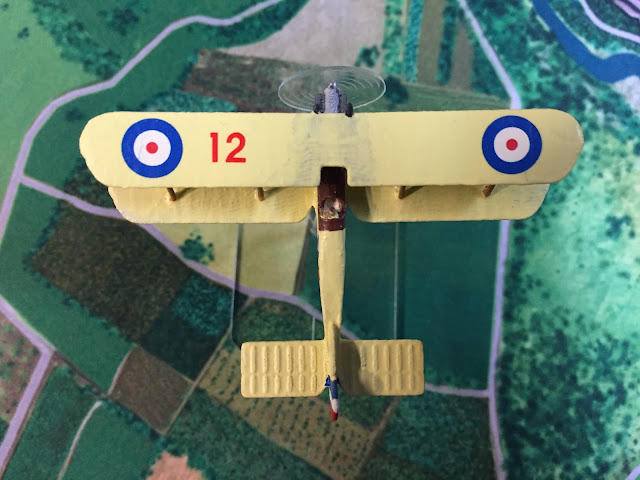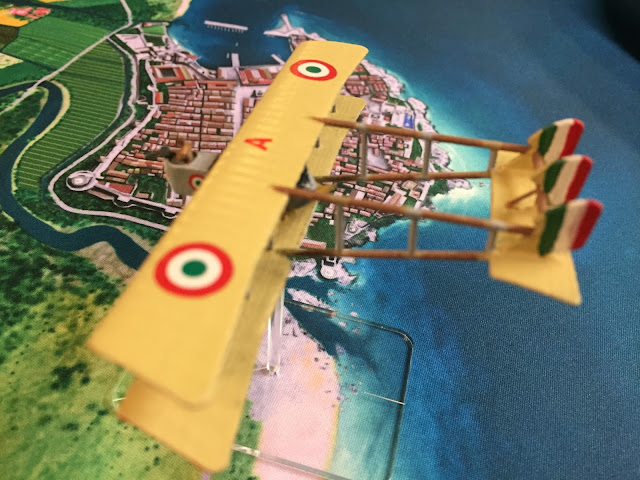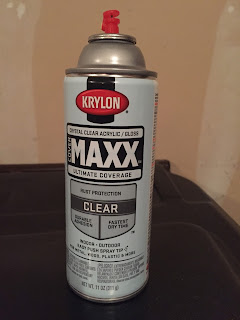Recently, we’ve been playing more early war. While it’s been
fun using the earlier fighters, I’ve grown weary of the same match ups of
Eindeckers, Moraines and DH.2 from the available models. There were a number of
early and mid-war planes used by the Allies that Wings of Glory does not yet
support that I’d like to see on the table. I won’t get into a discussion of why
that’s the case other than to say as an old school gamer, I’m in the camp of
right rules for it and let me worry about finding a model.
In my last order with
Shapeways,
I chose to expand our gaming options by through the acquisition of several
pusher planes. Though ultimately an unsuccessful design path, pushers served
extensively during the war, in some theaters right up to the end.
For the early war period, I selected the Vickers FB-5 ‘Gunbus’.
Without a synchronizer, the Gunbus used the pusher design to give the gunner a
wide field of fire to the front. Vulnerable to fire from the rear, slow and
with poor maneuverability, the FB-5 was
withdrawn from combat in 1916 when the Germans began fielding Halberstadt’s and
Albatross biplane fighters.
 |
| The FB 5 on the left in the middle of the painting process. |
 |
| Almost finished! Roundels from Dom's Decals. Number decals from Woodland Scenics. |
 |
| The model has a magnetic ball bearing attached to the bottom which allows it to pivot on the top of the stand. |
 |
| Here the plane is pitched up in a climb. The ball bearing is clearly visible on the bottom. |
 |
| ...And pushed over into a dive.This is about the limit of the pitch down. The support peg is hitting the landing gear struts. Decals on the tail are salvaged from an old Avro CF-105 model kit. |
The stop gap solution to the new German fighters was another
British pusher design – the Royal Aircraft Factory FE.2c. Similar to the FB-5
with a two man crew and pusher layout, the FE.2c was a larger aircraft that
mounted an additional machinegun mounted on a pedestal giving the gunner the
ability to shoot to the rear of the aircraft. To use the rear gun, the gunner
would stand in/on the cockpit and shoot to the rear –
seeing
in done on the ground was one thing, but imagine doing this in air combat
with the plane pitching about and you with no parachute!
 |
| The Shapeways FE.2c in the final stages of decaling. |
 |
| All based up and ready for gaming. Unlike the FB 5 this model has a flat magnet on the base which does not allow the model to be pitched about it's axis. Decal's are also from Dom's Decals and Woodland Scenics. You can see a bit of graininess to the upper surface of the right lower wing. This is an effect of the White Strong and Flexible material. It's a bit exaggerated in this close up. At normal gaming distances, you don't notice it. |
 |
| Rear view of the model on it's base. The playing mat is from the Nexus Wings of Glory product line. |
 |
| Front port quarter view. The crew were printed in the cockpit as was the forward gun. The rear MG is not modeled. Decals from Dom's Decals and Woodland Scenics. |
The FE.2c served through Spring of 1917 being the main
victim of the German fighters during “Bloody April”. They were soon superseded
by the Sopwith Pup and Camel and relegated to Home Defense and training
squadrons.
Last up and really more of a late war plane is the
Savoia-Pomelio SP 3. A pusher design that was an Italian evolution of the French
Farman pusher, the SP 3 retains
many of
the features seen in the prior examples above. A two seat biplane pusher armed
with a machinegun (or more rarely a 20mm cannon) the SP 3 was used extensively
for reconnaissance and artillery observation well into 1918.
 |
| The SP-3 nears the end of painting. The tricolors on the vertical stabilizers had to be hand painted. I can't paint a straight line to save my life. You make do with what you have. The gunner and the MG were 'printed' as part of the model. |
 |
| With most of the decals applied. Dom's Decals was the source of the roundels. The nice thing about Italian planes is they use half as many roundels as other countries because the bottom of the lower wing has the national colors painted across the entire surface. I'll look for a picture of it... |
 |
| Quarterview showing off the struts of the tail booms. |
Like most other
pushers it was slow with poor maneuverability, especially compared to the much
more modern designs in use by 1918. In a perfect world, it would have been
retired and replaced with Pomelio PD and PE two seater biplanes, but the disastrous
retreat of the
Twelfth
Battle of the Isonzo (Better known as Caporetto) resulted in the loss of massive
numbers of Italian aircraft. While the Italian RFC regrouped and re-equipped
with the more modern designs, the SP3 was retained in service. It was not until
summer of 1918 that the SP3 was replaced.
 |
| It's 1918 and the SP3 has been caught out by this Phonix C.II (Another model from Shapesways to be covered in a future post) |
 |
| The Phonix C.II gains position to the rear, unless the Haroit HD-1's join the fight, the SP3 is in serious trouble. The C.II is on a base from the Aerodrome, while the SP3 is on a base from Litko Game Accessories. |
These were all easy models to produce. The great thing about
3D printing is not having to fuss with assembling struts and booms – the whole
model is assembled and ready for painting. All three were printed using
White Strong
and Flexible (WSF) material.
For painting, I’ve come to believe that the most important
step is surface preparation. The porous, gritty nature of the WSF material can
be corrected. I use diluted PVA glue for the first soaking to file the
subsurface, but following that I used multiple light coats of gloss clear coat.
It can take many repeated coats, but the results pay off in a smooth surface
that takes primer and paint very well.
The planes were painted with a mix of acrylic craft paints
(Americana, Alene’s, etc.) and Vallejo paints. Camel was used for the wings on
the FB5 and FE2. Vallejo Buff was used on the SP3 wings. Sky Gray is a great
match for much of the gray skins and struts. Brown Violet is the stand in for
the PC10 Olive Drab color and flat brown/cork brown.































































